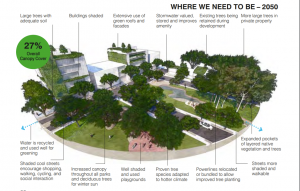Virginia Simpson-Young, Glebe Society Bulletin, May 2021
City of Sydney is consulting on their draft Greening Sydney Strategy. The consultation period ends on 24 May.
Making Sydney greener has many benefits including managing urban heat (which is getting worse because of climate change and urbanisation), more opportunities to connect with nature (which is important for mental and physical health) and greater biodiversity by, for example, creating more habitat for non-human animals.

There are six ‘Directions’ in the strategy. The first includes a target to increase overall green cover to 40% by 2050 (from 32% in 2019). This includes a minimum of 27% tree canopy (up from 18% in 2019). Note that ‘green cover’ is all of the trees, plants, ground covers and turf throughout the city; canopy cover relates solely to trees over three metres tall. Shrubs and lawns under canopy are not counted.
One way overall green cover can be increased, the Strategy says, is to green laneways: “It is no longer considered appropriate that laneways, as underused public spaces, are not better designed to become a valued green network for the entire community.”
An interesting idea falls under Direction 3; specific ‘calm green spaces’ will be identified or created. These calm spaces will be mapped and promoted and considered in future design. City of Sydney will also look into the possibility of temporary and ‘pop-up’ parks and green spaces ‘that provide new calming or respite in areas where permanent greening is not available’.
In terms of using planning instruments for greening Sydney, the City intends to develop a ‘green factor score’ which will be embedded in planning controls, including development control plans. This will help to increase greenery on private land.
There’s a lot more to the Strategy than I’ve described here. It can be viewed at https://tinyurl.com/52rhr9hc.










There are no comments yet. Please leave yours.